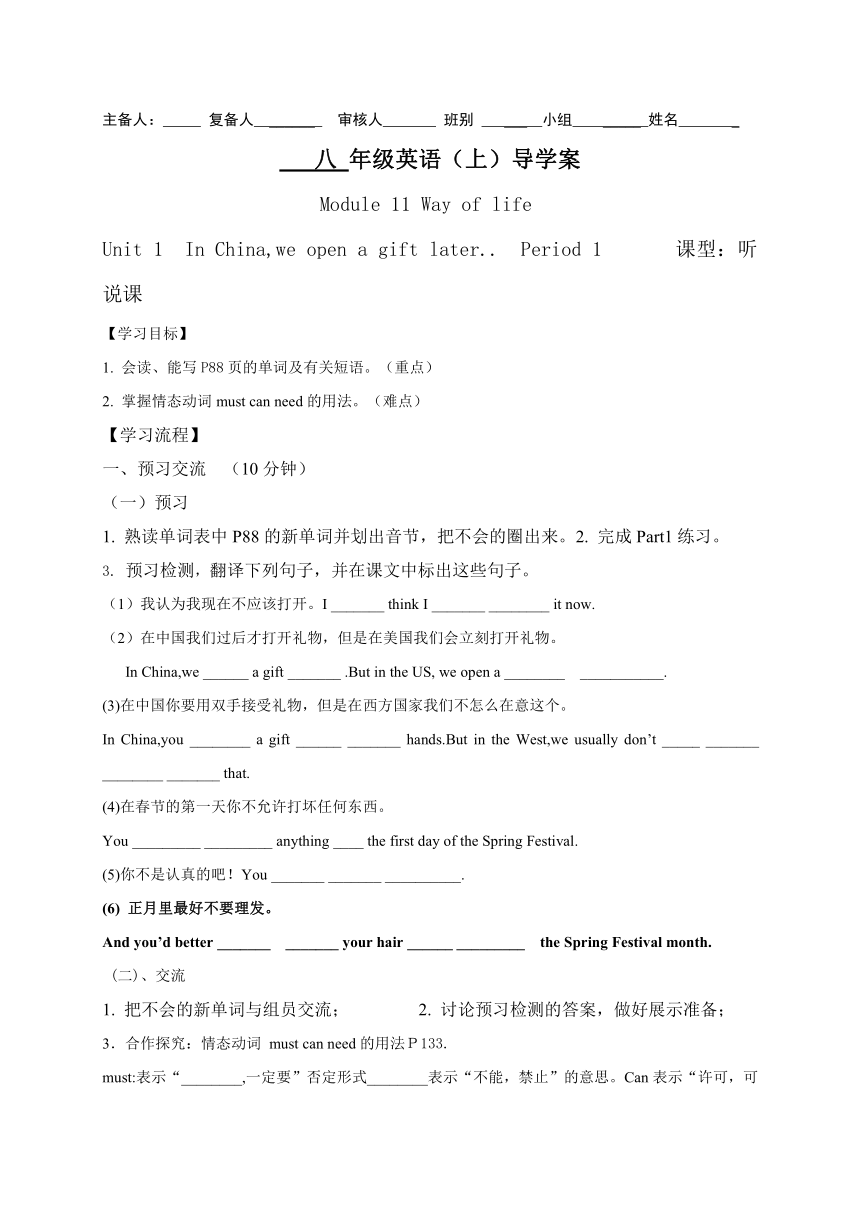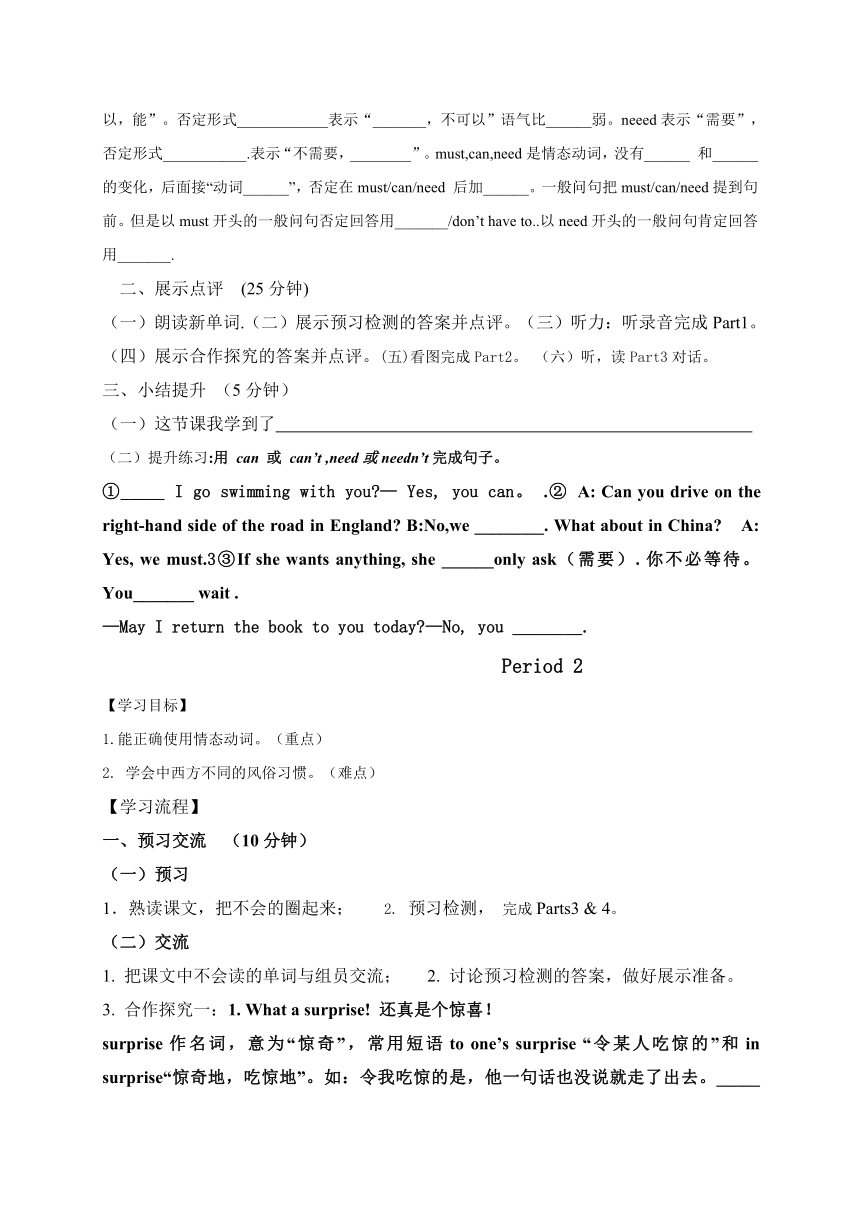外研版八年级英语上册Module11 Unit 1 In China we open a gift later听说课学案
文档属性
| 名称 | 外研版八年级英语上册Module11 Unit 1 In China we open a gift later听说课学案 |  | |
| 格式 | zip | ||
| 文件大小 | 120.8KB | ||
| 资源类型 | 教案 | ||
| 版本资源 | 外研版 | ||
| 科目 | 英语 | ||
| 更新时间 | 2017-07-16 21:26:38 | ||
图片预览


文档简介
主备人:
复备人
______
审核人
班别
___
小组
_____
姓名
_
八
年级英语(上)导学案
Module
11
Way
of
life
Unit
1
In
China,we
open
a
gift
later..
Period
1
课型:听说课
【学习目标】
1.
会读、能写P88页的单词及有关短语。(重点)
2.
掌握情态动词must
can
need的用法。(难点)
【学习流程】
一、预习交流
(10分钟)
(一)预习
1.
熟读单词表中P88的新单词并划出音节,把不会的圈出来。2.
完成Part1练习。
3.
预习检测,翻译下列句子,并在课文中标出这些句子。
(1)我认为我现在不应该打开。I
_______
think
I
_______
________
it
now.
(2)在中国我们过后才打开礼物,但是在美国我们会立刻打开礼物。
In
China,we
______
a
gift
_______
.But
in
the
US,
we
open
a
________
___________.
(3)在中国你要用双手接受礼物,但是在西方国家我们不怎么在意这个。
In
China,you
________
a
gift
______
_______
hands.But
in
the
West,we
usually
don’t
_____
_______
________
_______
that.
(4)在春节的第一天你不允许打坏任何东西。
You
_________
_________
anything
____
the
first
day
of
the
Spring
Festival.
(5)你不是认真的吧!You
_______
_______
__________.
(6)
正月里最好不要理发。
And
you’d
better
_______
_______
your
hair
______
_________
the
Spring
Festival
month.
(二)、交流
1.
把不会的新单词与组员交流;
2.
讨论预习检测的答案,做好展示准备;
3.合作探究:情态动词
must
can
need的用法P133.
must:表示“________,一定要”否定形式________表示“不能,禁止”的意思。Can表示“许可,可以,能”。否定形式____________表示“_______,不可以”语气比______弱。neeed表示“需要”,否定形式___________.表示“不需要,________”。must,can,need是情态动词,没有______
和______
的变化,后面接“动词______”,否定在must/can/need
后加______。一般问句把must/can/need提到句前。但是以must开头的一般问句否定回答用_______/don’t
have
to..以need开头的一般问句肯定回答用_______.
二、展示点评
(25分钟)
(一)朗读新单词.(二)展示预习检测的答案并点评。(三)听力:听录音完成Part1。
(四)展示合作探究的答案并点评。(五)看图完成Part2。
(六)听,读Part3对话。
三、小结提升
(5分钟)
(一)这节课我学到了
(二)提升练习:用
can
或
can’t
,need或needn’t完成句子。
①_____
I
go
swimming
with
you —
Yes,
you
can。
.②
A:
Can
you
drive
on
the
right-hand
side
of
the
road
in
England
B:No,we
________.
What
about
in
China
A:
Yes,
we
must.3③If
she
wants
anything,
she
______only
ask(需要). 你不必等待。You_______
wait
.
—May
I
return
the
book
to
you
today —No,
you
________.
Period
2
【学习目标】
1.能正确使用情态动词。(重点)
2.
学会中西方不同的风俗习惯。(难点)
【学习流程】
一、预习交流
(10分钟)
(一)预习
1.熟读课文,把不会的圈起来;
2.
预习检测,
完成Parts3
&
4。
(二)交流
1.
把课文中不会读的单词与组员交流;
2.
讨论预习检测的答案,做好展示准备。
3.
合作探究一:1.
What
a
surprise!
还真是个惊喜!
surprise作名词,意为“惊奇”,常用短语to
one’s
surprise
“令某人吃惊的”和in
surprise“惊奇地,吃惊地”。如:令我吃惊的是,他一句话也没说就走了出去。_____
______
________,
he
walked
out
without
saying
a
word.
约翰转过身来,惊奇地望着我。John
turned
around
and
looked
at
me_____
_________.
1.
We
are
secretly
preparing
a
birthday
party
to
give
Mum
a
_________.(惊喜)
2.
All
of
us
were
__________
(惊奇的)
that
such
a
little
girl
spoke
English
so
well.
4.
合作探究二:immediately做副词,意为“立刻,当即”相当于now,
right
now,right
away,at
the
moment。如:Be
quick!
The
game
will
begin
________.(2013天津)
A.
immediately
B.
recently
C.
carefully
D.
luckily
5.合作探究三:have
your
hair
cut理发
have+宾语+过去分词”结构表示“让某人做某事”。在该句型中宾语与宾补间为动宾关系,该宾补动作常由他人(非主语本身)来完成,因而含有被动意义。如:
小心,在这样的人群中容易被偷。It’s
easy
to______
your
pocket
_______
in
a
crowd
like
this.
He
wants
to
have
his
TV
________.
A.
repairing
B.
repaired
C.
to
repair
6.合作探究四:must
与
have
to 的区别
都表示“必须”但是must侧重说话者的主观看法,认为有必要,有义务去做某事have
to侧重于客观需要,有“被迫;不得不”的意思e.g.我们必须努力学习。We
______
work
hard.
昨天我的自行车坏了,所以我只能走路去学校。
My
bike
was
broken
yesterday,
so
I
______
_____
walk
to
school. 二、展示点评
(25分钟)
(一)朗读课文;
(二)展示预习检测的答案并点评(三)展示合作探究的答案并点评;
(四)听力:完成Parts5&6.
(五)
完成表格,展示并点评。
三、小结提升
(5分钟)
(一)这节课我学到了
________________
(二)提升练习
用can,
can’t,
must,
mustn’t或needn’t
填空完成句子。
1.
You
_________
listen
to
your
teacher
carefully
in
class.
2.
We
_________
cross
the
road
when
the
traffic
is
busy.
3.
You
_________
finish
all
of
the
work
today.
You
can
finish
it
tomorrow.
4.
I
________
draw
pictures,
but
I
really
want
to
learn.5.
You
________
eat
food
here
or
you
_________
go
somewhere
else.
主备人:
复备人
______
审核人
班别
___
小组
_____
姓名
_
复备人
______
审核人
班别
___
小组
_____
姓名
_
八
年级英语(上)导学案
Module
11
Way
of
life
Unit
1
In
China,we
open
a
gift
later..
Period
1
课型:听说课
【学习目标】
1.
会读、能写P88页的单词及有关短语。(重点)
2.
掌握情态动词must
can
need的用法。(难点)
【学习流程】
一、预习交流
(10分钟)
(一)预习
1.
熟读单词表中P88的新单词并划出音节,把不会的圈出来。2.
完成Part1练习。
3.
预习检测,翻译下列句子,并在课文中标出这些句子。
(1)我认为我现在不应该打开。I
_______
think
I
_______
________
it
now.
(2)在中国我们过后才打开礼物,但是在美国我们会立刻打开礼物。
In
China,we
______
a
gift
_______
.But
in
the
US,
we
open
a
________
___________.
(3)在中国你要用双手接受礼物,但是在西方国家我们不怎么在意这个。
In
China,you
________
a
gift
______
_______
hands.But
in
the
West,we
usually
don’t
_____
_______
________
_______
that.
(4)在春节的第一天你不允许打坏任何东西。
You
_________
_________
anything
____
the
first
day
of
the
Spring
Festival.
(5)你不是认真的吧!You
_______
_______
__________.
(6)
正月里最好不要理发。
And
you’d
better
_______
_______
your
hair
______
_________
the
Spring
Festival
month.
(二)、交流
1.
把不会的新单词与组员交流;
2.
讨论预习检测的答案,做好展示准备;
3.合作探究:情态动词
must
can
need的用法P133.
must:表示“________,一定要”否定形式________表示“不能,禁止”的意思。Can表示“许可,可以,能”。否定形式____________表示“_______,不可以”语气比______弱。neeed表示“需要”,否定形式___________.表示“不需要,________”。must,can,need是情态动词,没有______
和______
的变化,后面接“动词______”,否定在must/can/need
后加______。一般问句把must/can/need提到句前。但是以must开头的一般问句否定回答用_______/don’t
have
to..以need开头的一般问句肯定回答用_______.
二、展示点评
(25分钟)
(一)朗读新单词.(二)展示预习检测的答案并点评。(三)听力:听录音完成Part1。
(四)展示合作探究的答案并点评。(五)看图完成Part2。
(六)听,读Part3对话。
三、小结提升
(5分钟)
(一)这节课我学到了
(二)提升练习:用
can
或
can’t
,need或needn’t完成句子。
①_____
I
go
swimming
with
you —
Yes,
you
can。
.②
A:
Can
you
drive
on
the
right-hand
side
of
the
road
in
England
B:No,we
________.
What
about
in
China
A:
Yes,
we
must.3③If
she
wants
anything,
she
______only
ask(需要). 你不必等待。You_______
wait
.
—May
I
return
the
book
to
you
today —No,
you
________.
Period
2
【学习目标】
1.能正确使用情态动词。(重点)
2.
学会中西方不同的风俗习惯。(难点)
【学习流程】
一、预习交流
(10分钟)
(一)预习
1.熟读课文,把不会的圈起来;
2.
预习检测,
完成Parts3
&
4。
(二)交流
1.
把课文中不会读的单词与组员交流;
2.
讨论预习检测的答案,做好展示准备。
3.
合作探究一:1.
What
a
surprise!
还真是个惊喜!
surprise作名词,意为“惊奇”,常用短语to
one’s
surprise
“令某人吃惊的”和in
surprise“惊奇地,吃惊地”。如:令我吃惊的是,他一句话也没说就走了出去。_____
______
________,
he
walked
out
without
saying
a
word.
约翰转过身来,惊奇地望着我。John
turned
around
and
looked
at
me_____
_________.
1.
We
are
secretly
preparing
a
birthday
party
to
give
Mum
a
_________.(惊喜)
2.
All
of
us
were
__________
(惊奇的)
that
such
a
little
girl
spoke
English
so
well.
4.
合作探究二:immediately做副词,意为“立刻,当即”相当于now,
right
now,right
away,at
the
moment。如:Be
quick!
The
game
will
begin
________.(2013天津)
A.
immediately
B.
recently
C.
carefully
D.
luckily
5.合作探究三:have
your
hair
cut理发
have+宾语+过去分词”结构表示“让某人做某事”。在该句型中宾语与宾补间为动宾关系,该宾补动作常由他人(非主语本身)来完成,因而含有被动意义。如:
小心,在这样的人群中容易被偷。It’s
easy
to______
your
_______
in
a
crowd
like
this.
He
wants
to
have
his
TV
________.
A.
repairing
B.
repaired
C.
to
repair
6.合作探究四:must
与
have
to 的区别
都表示“必须”但是must侧重说话者的主观看法,认为有必要,有义务去做某事have
to侧重于客观需要,有“被迫;不得不”的意思e.g.我们必须努力学习。We
______
work
hard.
昨天我的自行车坏了,所以我只能走路去学校。
My
bike
was
broken
yesterday,
so
I
______
_____
walk
to
school. 二、展示点评
(25分钟)
(一)朗读课文;
(二)展示预习检测的答案并点评(三)展示合作探究的答案并点评;
(四)听力:完成Parts5&6.
(五)
完成表格,展示并点评。
三、小结提升
(5分钟)
(一)这节课我学到了
________________
(二)提升练习
用can,
can’t,
must,
mustn’t或needn’t
填空完成句子。
1.
You
_________
listen
to
your
teacher
carefully
in
class.
2.
We
_________
cross
the
road
when
the
traffic
is
busy.
3.
You
_________
finish
all
of
the
work
today.
You
can
finish
it
tomorrow.
4.
I
________
draw
pictures,
but
I
really
want
to
learn.5.
You
________
eat
food
here
or
you
_________
go
somewhere
else.
主备人:
复备人
______
审核人
班别
___
小组
_____
姓名
_
同课章节目录
- Module 1 How to learn English
- Unit 1 Let's try to speak English as much as possi
- Unit 2 You should smile at her.
- Unit 3 Language in use .
- Module 2 My home town and my country
- Unit 1 It's taller than many other buildings.
- Unit 2 Cambridge is a beautiful city in the east o
- Unit 3 Language in use .
- Module 3 Sports.
- Unit 1 Nothing is more exciting than playing tenni
- Unit 2 This year we training more carefully.
- Unit 3 Language in use .
- Module 4 Planes, ships and trains .
- Unit 1 He lives the farthest from school.
- Unit 2 What is the best way to travel.
- Unit 3 Language in use .
- Module 5 Lao She Teahouse.
- Unit 1 I wanted to see the Beijing Opera.
- Unit 2 It descibes the changes in Chinese society.
- Unit 3 Language in use .
- Module 6 Animals in danger.
- Unit 1 It allows people to get closer to them .
- Unit 2 The WWF is working hard to save them all.
- Unit 3 Language in use .
- Revision module A
- Module 7 A famous story
- Unit 1 Alice was sitting with her sister by the ri
- Unit 2 She was thinking about her cat.
- Unit 3 Language in use .
- Module 8 Accidents
- Unit 1 While the car were changing to red, a car s
- Unit 2 I was trying to pick it up when it bite me
- Unit 3 Language in use .
- Module 9 Population
- Unit 1 The population of China is about 1.37 billi
- Unit 2 Arnwick was a city with 200,000 people.
- Unit 3 Language in use .
- Module 10 The weathe
- Unit 1 It might snow.
- Unit 2 The weather is fine all year round.
- Unit 3 Language in use .
- Module 11 Way of life
- Unit 1 In China ,we open a gift later.
- Unit 2 In England, you usually drink tea with milk
- Unit 3 Language in use .
- Module 12 Help
- Unit 1 What should we do before help arrives?
- Unit 2 Stay away from windows and heavy furniture.
- Unit 3 Language in use .
- Revision module B
